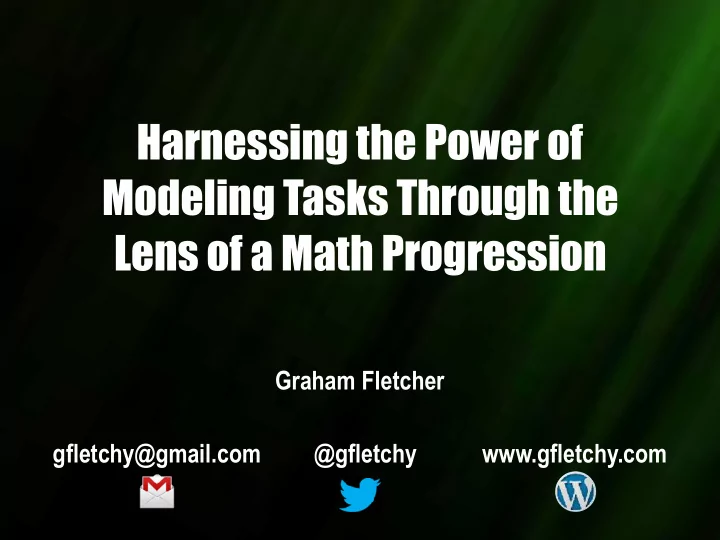

Harnessing the Power of Modeling Tasks Through the Lens of a Math Progression Graham Fletcher gfletchy@gmail.com @gfletchy www.gfletchy.com
Procedural Conceptual Fluency Understanding Application
@RobertKaplinsky
Demetrius has 17 Skittles which is 12 fewer than Alicia. How many Skittles does Alicia have?
Demetrius has 17 Skittles which is 12 fewer than Alicia. How many Skittles does Alicia have?
Demetrius has 17 Skittles which is 12 fewer than Alicia. How many Skittles does Alicia have?
Demetrius has 17 Skittles which is 12 fewer than Alicia. How many Skittles does Alicia have?
Demetrius has 17 Skittles which is 12 fewer than Alicia. How many Skittles does Alicia have?
17 12 fewer
17 12
17 12 W T F ?
17 12 W T F ? hat’s he ive
Current Research
You little plucker! John SanGovanni, NCTM ‘16
number You little plucker! John SanGovanni, NCTM ‘16
@gfletchy
?
The Big Reveal
Graham had some Skittles. He had 19 yellow, 15 orange, 19 green, 17 purple, and 21 red. How many Skittles did Graham have?
3-Act Tasks Act 1: • Real world problem or scenario presented • What do you notice? What do you wonder? • Make estimates Act 2: • Identify missing variables and missing variables to solve • Define solution path using variables Act 3: • Solve and interpret results of the solution • Validate answer
Most asked questions: • How often should we use 3-Act Tasks? • When should we use 3-Act tasks? How do they fit into the scope of a unit? • How long does one task usually take? • What if we don’t have the time?
5 The practices are: 1. Anticipating student responses to challenging mathematical tasks; 2. Monitoring students’ work on and engagement with the tasks; 3. Selecting particular students to present their mathematical work; 4. Sequencing the student responses that will be displayed in a specific order and; 5. C onnecting different students’ responses and connecting the responses to key mathematical ideas. MTMS: Vol. 14, No. 9, May 2009-5 Prac8ces for Orchestra8ng Produc8ve Mathema8cs Discussions
Sequence the order students will share during the closing.
19+15+19+17+21
1-counting all 1-counting all
2-counting all 1-counting all with skip counting 1-counting all
2-counting all 1-counting all with skip counting 1-counting all 3-making tens from ones
2-counting all 1-counting all 4-making tens with skip from ones counting 1-counting all 3-making tens from ones
5-Place value 2-counting all 1-counting all 4-making tens partitioning with skip from ones counting 1-counting all 3-making tens from ones
5-Place value 2-counting all 1-counting all 4-making tens partitioning with skip from ones counting 1-counting all 6-Partial Sums 3-making tens from ones
5-Place value 2-counting all 1-counting all 4-making tens partitioning with skip from ones counting 7-Landmark Numbers 1-counting all 6-Partial Sums 3-making tens from ones
5-Place value 2-counting all 1-counting all 4-making tens partitioning with skip from ones counting 7-Landmark Numbers 1-counting all 6-Partial Sums 3-making tens from ones
5-Place value 2-counting all 1-counting all 4-making tens partitioning with skip from ones counting 7-Landmark Numbers 1-counting all 6-Partial Sums 3-making tens from ones
gfletchy@gmail.com @gfletchy www.gfletchy.com/math-plus
Recommend
More recommend